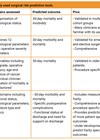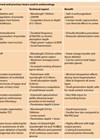Features
BAUS Annual Scientific Meeting 2024
Day 1 Toni Huw Mihailidis and Mriganka Mani Sinha Another year and another brilliant meeting in which urologists from the UK and around the globe assembled for a highly entertaining event. Day one kicked off with a topical and ever-pervasive...
From overseas to the UK: initial impressions
A few years ago we published stories from three international medical graduates detailing their experience of working as registrars in the UK (https://www.urologynews.uk.com/education/trainees-forum/post/initial-impressions-of-urology-in-the-uk-from-overseas-trainees). Here are three new countries and three new opinions. Dinelle Sirjuesingh, Trinidad and Tobago Trinidad and Tobago...
Shared decision-making – minimising the mismatch
In Western countries, we are spoilt for choice in almost every aspect of our lives, but does that reflect also in healthcare? While we have taken some big strides towards shared decision-making with our patients, the age-old physician dominance remains...
Systematic reviews and meta-analysis – a stepwise approach
As per Cochrane definition (2013), a systematic literature review (SR) attempts “to identify, appraise and synthesize all the empirical evidence that meets pre-specified eligibility criteria to answer a given research question” [1]. A meta-analysis (MA) is a statistical assessment of...
Delivering a trainee-led Urolink educational programme – my experience in Tanzania
In May 2023, I travelled to Moshi, Tanzania, where I visited Kilimanjaro Christian Medical Centre (KCMC) – a trip which was made possible through the collaborative efforts of the British Association of Urological Surgeons (BAUS) Urolink and with the support...
Urology National Selection: tips and tricks for a successful interview process
We invited Dominic Brown, the top-ranking candidate from the Urology National Training Selection Interview 2023, to share his wisdom on the interview process. Dominic is currently an ST3 working in North West London. Kelly Ong, Urology News Trainees Sub-Editor. 1....
Urology around the world: India: past, present, and future
Past India has the largest population in the world, standing at 1.43 billion as of September 2023. This vast population across a huge geographical area brings unique healthcare challenges, including the full range of urologic conditions. Urology is a relatively...
Urology around the world: Myanmar
In this article the author, a urologist from Myanmar, discusses the presentation, diagnosis and management of a condition common in his country. Urethral orifice stones Urolithiasis is one of the most common urological conditions, usually involving the kidneys, ureters and...
Frailty in urology – part 2
The first article in this series defined frailty and introduced the concept and importance of identifying patients living with frailty who undergo surgery, including those undergoing urological procedures. In the second part of this series we outline how to identify...
Frailty in urology – part 1
Part 2 of this topic can be found here Statement of the problem Clinical frailty carries an increased risk of poor health outcomes. The pathological process resulting in frailty is often overlooked and elucidating its aetiology and natural history are...
Renal calculi: the role of imaging in pregnancy
Nephrolithiasis is the most common cause of non-obstetric abdominal pain in pregnancy. Accurate diagnosis is imperative as stone related complications can lead to pre-eclampsia, urosepsis, and premature labour [1,2]. In the general population, non-contrast cross sectional imaging is recommended by...
What is new in lasers for endourology: looking into the future
From the first cystoscopic argon and neodymium-YAG (yttrium-aluminium-garnet) laser used for bladder tumours in 1976 by Staehler et al. [1], lasers have proven to be a versatile and an evolving tool in the therapeutic management of a variety of urological...















